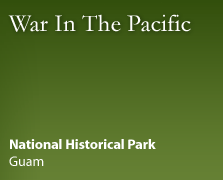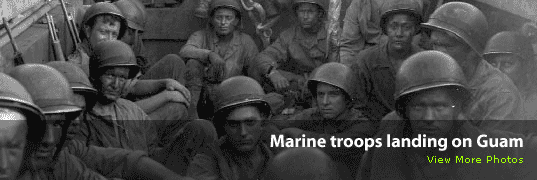|
With the establishment of War in the Pacific National Historical Park, the United States National Park System now extends across the Pacific Ocean. Authorized on August 18, 1978, the park was established "to commemorate the bravery and sacrifice of those participating in the campaigns of the Pacific Theater of World War II and to conserve and interpret outstanding natural, scenic, and historic values and objects on the Island of Guam.."
Like many other Pacific Islands, Guam contains historical features associated with World War II, especially the 1944 American liberation. The park itself consists of seven separate units. They are located in or near the villages of Asan, Piti, and Agat, on the west side of the island facing the Philippine Sea.
The Asan Beach Unit is the site of the northern landing beach, It was here that the 3rd Marine Division came ashore for the initial assault and was met by troops of the Japanese 320th Independent Infantry Battalion. War-related structures are located at Asan Point and Adelup Point. The remains of some American military equipment and coral-encrusted ordnance lie underwater in the offshore area.
The T. Stell Newman Visitor Center and Park Headquarters is closed due to damage from Supertyphoon Pongsona.
At Asan Point, the "Liberators' Memorial," installed during the Liberation of Guam 50th Anniversary ceremonies, honors veterans of the armed forces who participated in the 1944 landing. The Guam Combat Patrol is also honored for helping the Americans scout out Japanese stragglers. Funding was provided by the Guam Chapters of the National Association for Uniformed Services and the Third Marine Division Association, and by the people of Guam.
Discover hidden Japanese fortifications and historic sites along the Asan Ridge Trail. More than 50 years ago, Chamorros were forced to build these Japanese defenses.
The Asan Inland Unit is directly opposite the Asan Beach Unit across Marine Drive. It was on the face of these cliffs and hillsides that the American landing forces met heavy resistance. Today, thick jungle growth or swordgrass savannah covers the area, making hiking fairly difficult.
Asan Bay Overlook, on Route 6, contains a memorial garden in honor of Chamorros and Americans who died on Guam during the war years. Their names are inscribed on the memorial walls along with the names of Chamorros who endured the hardships of war through injury, forced labor, forced marches, and internment. Bronze panels illustrate scenes of the invasion, occupation, and liberation of the island. The site provides a panoramic view of the Asan landing beach. At this unit there is also the Sons of Guam Pearl Harbor Memorial. This memorial honors the Chamorro men who died during the attack on Pearl Harbor.
The Piti Guns Unit is on the ridge behind the village of Piti. After a steep ascent, the 1/4-mile trail leads to three Japanese coastal defense guns.
The Mt. Chachao/Mt. Tenjo Unit provided the Japanese defenders with a view of United States troops landing at Asan Beach and a scenic overview of Apra Harbor and Orote Point. The unimproved trail leads to foxholes, trenches, and a World War I American gun emplacement.
The Agat Unit is the site of the southern landing beach. It was here that the First Provisional Marine Brigade and the 305th Regimental Combat Team of the 77th Army Infantry Division came ashore. They were met by the Japanese 1st Battalion, 38th Infantry. Apaca Point, Ga'an Point, Bangi Point, and Bangi Island contain historic sites and structures, including caves, bunkers, latrine foundations, and pillboxes.The beach and offshore area here are relatively unspoiled and provide a good impression of how they looked in 1944. Several pieces of American military equipment still lie underwater near the edge of the reef.
The Mt. Alifan Unit, site of a former Japanese command post, contains the remains of bomb craters, fox holes, and trenches. The slopes of these hills saw intense battles between United States Marines and the defending Japanese forces. This area is undeveloped, making access difficult.
The Fonte Plateau Unit, site of a former Japanese naval communications center, is currently undeveloped.
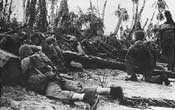 |
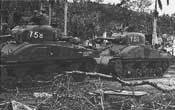 |
| Marines take cover behind bomb and shell debris and fallen coconut trees, July 1944. |
U.S. Army tanks of the 77th Infantry Division take a few moment's rest to view the damaged ruins of Agana (now Hagåtña). |
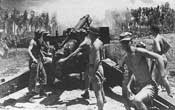 |
| Marines of the III Amphibious Corps Artillery fire one of their 155-mm. howitzers in support of the 305th Infantry's attack on the Orote Peninsula, July 22-24, 1944. |
|




